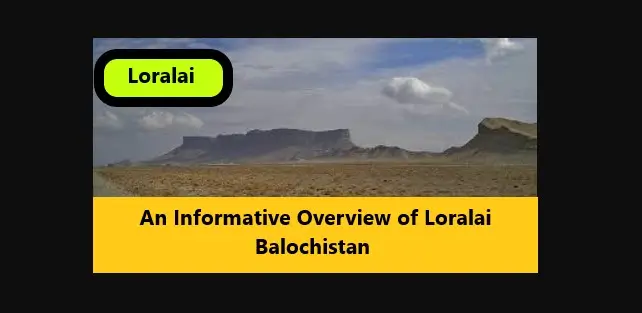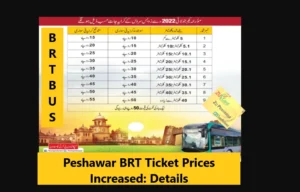An Informative Overview of Loralai Balochistan.
A Historical and Cultural Gem in Balochistan
Loralai District, nestled in the northeastern corner of Pakistan’s Balochistan province, boasts a rich tapestry of history.
Read More: Lasbela District: Explore the Hidden Gem
This informative guide dives deep into Loralai’s past, demographics, healthcare facilities, educational institutions, and must-see attractions.
A Journey Through Time:
While the earliest history of Loralai remains shrouded in mystery, clearer accounts emerge around the 15th century.
Back then, Loralai belonged to the Kandahar province in Afghanistan. The region witnessed a dynamic power struggle, with control shifting between the Mughal, Safavid, and Afghan empires.
- Mughal and Safavid Rule (16th Century): In 1545, Mughal Emperor Humayun granted control of Duki, a dependency of Kandahar, to Mir Sayyid Ali. However, Mughal dominance was short-lived, as the Safavids seized Kandahar in 1559, holding it until 1595.
- British Colonial Era (19th Century): The 19th century marked the arrival of the British Raj. By 1887, Loralai became part of British India. A defining moment arrived in 1903 with the official creation of Loralai District, incorporating territories from neighboring districts.
- Part of Pakistan (20th Century – Present): Following Pakistan’s independence in 1947, a referendum confirmed Loralai’s desire to join the newly formed nation. The district remained largely unchanged until 1992 when Barkhan Tehsil separated to become a distinct district.
Beyond History: Exploring Loralai Today
This comprehensive guide extends beyond history, offering valuable insights for those interested in Loralai today.
You’ll find details on demographics, healthcare facilities, educational institutions, and captivating places to visit, ensuring a well-rounded understanding of this unique district.
Let’s delve deeper into the makeup of Loralai District and its weather patterns.
Loralai by the Numbers:
- Population: Loralai boasts a population of around 397,400.
- Gender Breakdown: The district leans slightly male, with 53.46% identifying as male and 46.53% as female.
- Household Size: The average household size varies slightly between urban and rural areas. In urban areas, the average household is 7.44 people, while rural areas have an average of 7.05. The overall district average sits at 7.11 people per household.
- Literacy Rate: Literacy rates in Loralai are on the rise, with an overall rate of 42.42%.
- Languages Spoken: Pashto is the dominant language, spoken by 93.29% of the population.
Loralai’s Climate:
Nestled in Balochistan, Loralai experiences a warm to hot climate with distinct seasonal variations.
- Sunshine Days: The district enjoys ample sunshine year-round.
- Summer: Prepare for hot summers! From June to September, average highs can reach around 35°C (95°F).
Loralai’s Climate: Sunshine, Warmth, and Seasonal Shifts
Loralai’s climate offers a beautiful contrast between warm, sunny days and mild winters. Here’s a breakdown of what to expect throughout the year:
Summer Sunshine (June – September):
- Expect plenty of sunshine and high temperatures.
- Average highs reach around 35°C (95°F), making it quite hot.
Milder Winters with Occasional Rain (December – February):
- Winters provide a welcome respite from the summer heat.
- Average lows drop to around 5°C (41°F).
- Rainfall is infrequent but can occur during this period.
Pleasant Interludes: Spring (March – May) and Autumn
- Spring and autumn offer the most comfortable temperatures for exploring Loralai.
- Enjoy sunny days without the intense summer heat.
Low Rainfall Throughout the Year:
- The district experiences generally low rainfall, with most occurring in winter.
Wind Patterns and Sun Protection:
- Southerly winds influence the overall climate.
- The UV index can be high, especially in summer. Sun protection is crucial when visiting Loralai.
Additional Considerations:
- Mountainous Terrain: Temperatures can vary depending on elevation. Higher altitudes tend to be cooler.
- Continental Climate: Due to its inland location, Loralai experiences larger temperature variations between day and night compared to coastal areas.
Planning Your Visit:
Loralai’s climate offers distinct seasons. Consider the time of year when planning your trip:
- For comfortable exploration, choose spring or autumn.
- Pack accordingly, with sun protection being essential year-round, especially in summer.
- Be prepared for hot summer days, but enjoy the pleasant relief of winter and the beauty of spring and autumn.
Unveiling Loralai’s Gems: Historical Sites, Natural Wonders, and More
Loralai District offers a captivating blend of history, natural beauty, and cultural experiences. Here’s a glimpse into some of the must-visit places:
Unveiling the Past: Historical Sites
- Rana Ghundai Archaeological Mound: Embark on a journey through time at the Rana Ghundai Archaeological Mound, located 16 km north of Loralai town. This pre-historic site dates back to the Chalcolithic to Bronze Age. Excavations unearthed a treasure trove of tools, pottery, and other artifacts, offering a window into the lives of the region’s ancient inhabitants.
Witnessing Nature’s Majesty: Natural Wonders
- Karakul Mountain: Prepare to be awestruck by the majestic Karakul Mountain, a unique table-top mountain located in Chinijan village. This natural wonder boasts a massive rocky plateau stretching 4 km in length and nearly half a kilometer wide. Standing tall at an elevation of 7,835 feet, Karakul Mountain offers breathtaking panoramic views and a chance to experience the raw beauty of Loralai’s landscape. Karakul Mountain, Loralai
A Taste of Loralai’s Bounty: Fruit Orchards
- Lush Green Orchards: Loralai is renowned for its verdant orchards that carpet the land alongside streams. These orchards brim with a variety of fruits like apples, almonds, apricots, pears, cherries, pomegranates, and more. While visiting these orchards might require permission from landowners, the chance to witness the region’s agricultural abundance is a unique and rewarding experience.
Medical Facilities in Loralai
Loralai District is well-equipped with medical facilities to cater to your needs. Here are some of the prominent ones:
- DHQ Hospital: The District Headquarters Hospital (DHQ) serves as the main healthcare facility in the area, providing comprehensive medical attention to the community.
- Hashim Medical Complex Loralai: This 24/7 operational hospital offers a wide range of medical services to the residents of Loralai.
- Dr. Zareena Hospital: Another reliable option for medical care in Loralai is Dr. Zareena Hospital, which also operates 24/7.
Reaching Loralai: How to Get There
Loralai is accessible from various parts of Pakistan. Here are the routes to consider depending on your starting point:
- Islamabad: Take the M-1 Motorway south towards Quetta. From Quetta, follow N-50 National Highway east until you reach Loralai town.
- Karachi: Travel north on the N-55 National Highway until Sukkur. Take the M-8 Motorway westward towards Quetta. From Quetta, follow N-50 National Highway east until you reach Loralai town.
- Lahore: Take the M-2 Motorway southwest towards Multan and Sukkur. From Sukkur, take the M-8 Motorway westward towards Quetta. From Quetta, follow N-50 National Highway east until you reach Loralai town.
This curated list provides a starting point for exploring Loralai’s hidden treasures. Whether you’re a history buff, a nature enthusiast, or simply seeking a unique cultural experience, Loralai has something to offer everyone.
Loralai District in Balochistan, Pakistan, enchants visitors with its captivating story. Layers of history, from ancient settlements to the complexities of the colonial era, weave a rich tapestry waiting to be explored.
A Glimpse into the Past and Present
While specific details about established tourist destinations might be limited, Loralai’s potential for exploration is undeniable.
- Unearthing the Past: Delve into history at the Rana Ghundai Archaeological Mound, a testament to the region’s ancient inhabitants.
- Nature’s Majesty: Be awestruck by the breathtaking Karakul Mountain, a unique table-top wonder offering panoramic views.
- Balochi Culture: Immerse yourself in the vibrant Balochi way of life, experiencing traditions and witnessing the region’s agricultural bounty in its lush green orchards.
Loralai caters to the adventurous traveler seeking a unique blend of history, nature, and cultural experiences.
Frequently Asked Questions (FAQs): An Informative Overview of Loralai Balochistan
- What makes Loralai District special?
Loralai boasts a rich tapestry of history, dating back to the pre-historic era. Explore ancient archaeological sites, experience the unique Balochi culture, or simply soak in the beauty of the scenic mountains and orchards.
2. How do I get to Loralai District?
Currently, trains are not a viable option for reaching Loralai. Your primary mode of transportation will be by road. National Highway N-50 connects Loralai to Quetta, while other regional roads provide access to nearby towns.
3. What’s the weather like in Loralai District?
Loralai experiences a warm to hot climate with distinct seasons. Summers are sunny and hot, with highs reaching 35°C (95°F). Winters are mild with occasional rain, while spring and autumn offer pleasant escapes.
4. Is it safe to visit Loralai District?
It’s crucial to research the current security situation before your visit. Limited tourist infrastructure necessitates a focus on safety and cultural sensitivity. Respect local customs and dress modestly to ensure a smooth and enjoyable experience.
Loralai awaits those seeking to venture beyond the ordinary. Let this guide be your starting point for crafting an unforgettable adventure in this captivating district.
Note: The information above might not be accepted 100%. Please verify from your own sources. We will not be responsible for any kind of loss due to our content.
For more news, please visit Munafa Marketing.




